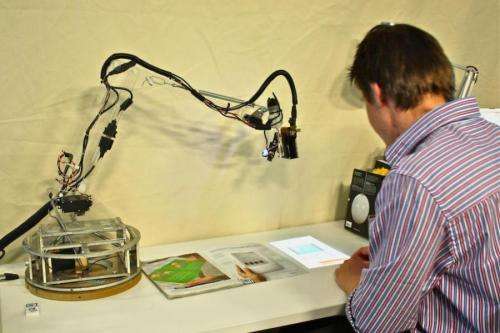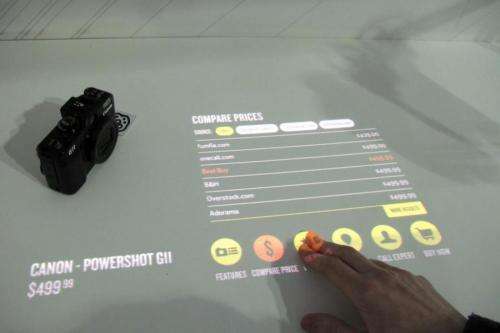LuminAR
(Phys.org)—Are we moving closer to a computer age where "touchscreen" is in the room, but it is the counter, desktop, wall, our new digital work areas? Are we moving into a new form factor called Anywhere? Do we understand how locked up we are in on-screen prisons, and that options will come? The drive for options is strong at the MIT Media Lab, where its Fluid Interfaces Group has been working on some AR options, the "Augmented Product Counter" and the "LuminAR." The latter is a bulb that makes any surface a touchscreen. You can even use it to replace the bulb in a desk lamp with the MIT group's "bulb" to project images onto a surface. The LuminAR bulb is small enough to fit a standard light fixture.
The LuminAR team, Natan Linder, Pattie Maes and Rony Kubat, described what they have done as redefining the traditional incandescent bulb and desk lamp as a new category of "robotic, digital information devices." This will be one of the new looks in AR interfaces.
The LuminAR lamp system looks similar to a conventional desk lamp, but its arm is a robotic arm with four degrees of freedom. The arm terminates in a lampshade with Edison socket. Each DOF has a motor, positional and torque sensors, motor control and power circuitry. The arm is designed to interface with the LuminAR bulb. The "bulb," which fits into a lightbulb socket, combines a Pico-projector, camera, and wireless computer and can make any surface interactive. The team uses the special spelling "LuminAR" to suggest its place in the group's other Augmented Reality initiatives.
"The Fluid Interfaces research group is radically rethinking the ways we interact with digital information and services," says the MIT site. Their mission is to investigate ways to augment everyday objects and spaces around people, making those objects and spaces responsive to users' actions.
Their "Augmented Product Counter" is based on LuminAR technology, which, in a retail store setting, can transform any standard product counter into a digital entity where the countertop will display the digital information related to the physical product. Potential scenarios include shoppers using the counters to learn more about the products as well as web access to reviews and price comparisons.
Augmented Product Counter
The LuminAR bulb can be a standalone unit. Users can interact with its projection through hand gestures for zoom, position control, and content manipulation. If used with the LuminAR lamp it takes on more functionality, with the articulated robotic arm enabling a user to move projected images around.
LuminAR was showcased earlier this year at an ACM conference. "I'm really excited by the way this would be used by engineers and designers," said Linder. Applications, aside from retail, could lie in numerous professional fields where people need to work with paper and other physical tools alongside their computers. The project is a re-think of traditional lighting objects, giving them new power as augmented-reality interfaces.
In a November Technology Review, the LuminAR team was reported to be finessing the bulb-only version. Linder said its design cuts costs and complexity, and makes the technology easier to adopt.
More information:
fluid.media.mit.edu/projects/luminar
fluid.media.mit.edu/projects/a … nted-product-counter
© 2012 Phys.org

























